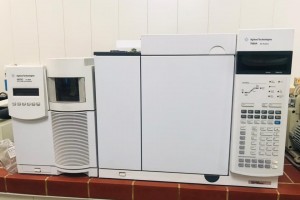
The College of Education for Pure Sciences at the University of Basra discussed a doctoral thesis on (preparation and characterization of some magnetic nano-spinning ferrite compounds and their use as adsorbent surfaces to treat pollution by elements and oil pollution from their solutions)
The thesis presented by the researcher (Ahmed Youssef Hammoud) included pollution as one of the major problems facing man and the environment, especially after the technological development accompanying contemporary life. In the proportions of some basic components in the environment from their natural proportions, and this happens through human intervention or some natural phenomena.
The thesis was taken
The first axis dealt with the preparation and diagnosis of five compounds of magnetic nano-spin ferrites with the formula NiFe2O4 ((A1, CoFe2O4 (A2), ZnFe2O4 (A3), Co0.33Ni0.33Zn0.33Fe2O4 (A4) and Co0.5Ni0.5Fe2O4 (A5). Addressing the use of prepared nanocomposites as adsorbent surfaces in the process of adsorption of lead, cadmium and petroleum hydrocarbon ions from their aqueous solutions, with the aim of knowing the effectiveness of these surfaces and the possibility of using them as adsorbent surfaces to treat cases of pollution with these pollutants.
The aim of the thesis
Preparation of magnetic spin ferrites with nanoscale dimensions in a relatively inexpensive and environmentally friendly way, and it is among the methods of green chemistry and from materials available using lemongrass fruit extract, using the spontaneous combustion sol-gel method.
And the use of several techniques to diagnose the prepared nanomaterials, including:
(BET, Zeta Potential, EDX, FESEM, TEM, XRD, FTIR).
And the use of prepared nanocomposites as adsorbent surfaces to remove ions of lead, cadmium and petroleum hydrocarbons from their aqueous solutions and to show the extent to which these prepared surfaces are capable of adsorption of these pollutants.
A study of some factors affecting the adsorption process, including (acidity function, temperature, concentration of ions of lead, cadmium and petroleum hydrocarbons), in addition to finding suitable isotherms for adsorption and determining their constants.
Calculation of the thermodynamic functions of the adsorption process at different temperatures.
The comparison between the five prepared surfaces in their efficiency for adsorption of ions of lead, cadmium and petroleum hydrocarbons from their aqueous solutions.
And to indicate the possibility of activating the prepared absorbent surfaces and reusing them several times to remove pollutants from their aqueous solutions.








